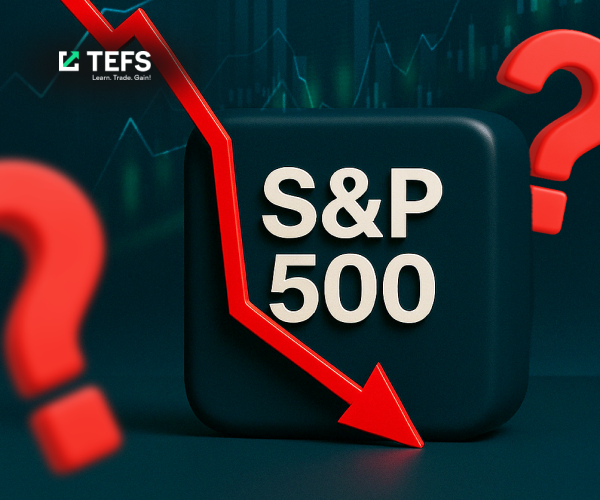Nvidia caught in the storm 16/04/2025

HOT stories for today
US market wrap:
- U.S. equities recorded slight declines on Tuesday as traders assessed a fresh wave of first-quarter earnings results while taking some relief from the recent decrease in market volatility. The Dow Jones Industrial Average slipped 0.38%, the S&P 500 dipped 0.17%, and the Nasdaq Composite edged lower by 0.05%. These subdued movements stood in sharp contrast to the sharp fluctuations observed in prior sessions. The CBOE Volatility Index (VIX), commonly referred to as Wall Street’s "fear gauge," dropped to approximately 30 after peaking near 60 last week.
- Meanwhile, both the S&P 500 and Nasdaq 100 formed a "death cross" — a bearish technical signal — as their 50-day moving averages fell below their 200-day moving averages for the first time since 2022. Piper Sandler cautions that the market isn't "out of the woods yet," highlighting that continued volatility surrounding tariff policy could lead to further unpredictable swings in the near term.
Nvidia caught in the storm
- Nvidia said Tuesday it expects to take a charge of up to $5.5 billion in its fiscal first quarter due to new U.S. export restrictions on its H20 chips, which were specifically designed for the Chinese market. The announcement sent shares down 6.3% in after-hours trading. In an SEC filing, Nvidia disclosed that the U.S. government now requires an export license to sell H20 chips to China, including Hong Kong and Macau — a rule expected to remain in place indefinitely. Analysts believe Nvidia is unlikely to receive such a license.
- The writedown reflects inventory and purchase commitments for chips no longer sellable in China. Analyst Gil Luria called the disclosure “opaque” and said more clarity will come once the government releases full export guidelines. Analysts have warned the move could effectively cede the Chinese AI chip market to Huawei. Bernstein’s Stacy Rasgon previously said banning H20 would “simply hand the Chinese AI market to Huawei.” Nvidia’s fiscal Q1 ends April 27, and its recent earnings already showed a sharp drop in China revenue. China’s share of Nvidia’s total revenue has dropped from 26% in 2022 to a projected 13% for fiscal 2025. Wall Street analysts are expected to cut their forecasts in response to the new restrictions.
Stocks on the move:
- United Airlines (UAL) — Shares jumped nearly 7% after reporting first-quarter adjusted earnings of $0.91 per share, surpassing the $0.76 estimate from analysts surveyed by LSEG.
- Interactive Brokers (IBKR) — The stock declined 5% after the online trading platform posted Q1 earnings of $1.88 per share, missing the $1.92 consensus estimate from LSEG.
- J.B. Hunt Transport Services (JBHT) — Shares dropped 6% even though the company beat both revenue and earnings expectations in Q1. Still, revenue and operating income declined year over year.
- Omnicom Group (OMC) — The stock fell more than 2% despite first-quarter adjusted earnings of $1.70 per share, topping the $1.62 per share expected by LSEG analysts.
Today’s action
- Asia-Pacific markets traded mostly in the red on Wednesday, following Wall Street’s overnight decline as investors digested quarterly earnings and remained cautious over tariff tensions. Hong Kong’s Hang Seng Index fell 2.11%, while mainland China’s CSI 300 slipped 0.84%. This came despite China’s economy growing by a stronger-than-expected 5.4% in Q1. Japan’s Nikkei 225 edged down 0.3%, and South Korea’s Kospi declined 0.47%. The Kosdaq, focused on small-cap stocks, lost 0.44%.
- Meanwhile, U.S. stock futures fell Tuesday night ahead of key economic data and more earnings reports. Dow futures dropped 194 points (0.5%), while S&P 500 and Nasdaq 100 futures fell 0.9% and 1.5%, respectively. Markets are awaiting March’s retail sales report, due Wednesday morning, at a time when consumer confidence is under pressure from inflation concerns. Investors are also watching for updates on industrial and manufacturing production. Wednesday will also bring a fresh wave of earnings, with reports expected from Travelers (TRV), U.S. Bancorp (USB), Abbott Labs (ABT), ASML (ASML), and Citizens Financial (CFG).
Watchlist: NVDA, JBHT, UAL, ABT, ASML, TRV, PLTR, TSLA
Bitcoin
- Bitcoin (BTC) briefly surged to $86,000 on Tuesday morning before retreating below $85,000, as growing fears of a potential U.S. recession unsettled investors. A poll of 46 economists conducted by Wolters Kluwer showed a 47% chance of a recession by year-end, according to USA Today.
- Bitcoin’s market cap now sits at $1.69 trillion, reflecting its 24-hour price gain. BTC dominance also rose to 63.85%, up 0.26%, signaling outperformance over altcoins. The rally highlights Bitcoin’s perceived role as a hedge amid macroeconomic uncertainty.
Watchlist: Bitcoin: 74 000-100 000, Ethereum:1500-2600, Solana: 80-150
Forex
- The Japanese Yen (JPY) attracted fresh buying during Wednesday’s Asian session, pushing the USD/JPY pair down toward the mid-142.00s. Investors continued to seek safe-haven assets amid persistent trade uncertainty surrounding U.S. tariffs, fueling JPY demand. Hopes for a potential U.S.-Japan trade agreement and a sharp rebound in Japan’s core machinery orders in February further supported the currency. Speculation over a possible Bank of Japan rate hike also added to the bullish sentiment. Meanwhile, dovish expectations for the Federal Reserve continued to pressure the U.S. Dollar (USD).
- The EUR/USD pair edged up to around 1.1340 during the Asian session, recovering after two days of losses. The Euro found support from an improved global risk tone following President Trump’s decision to exempt key tech products from newly proposed “reciprocal” tariffs. However, the Euro may face pressure ahead of Thursday’s European Central Bank meeting, with markets anticipating a 25-basis-point rate cut. According to the CME FedWatch tool, traders are also pricing in approximately 85 basis points in Fed rate cuts by year-end.
Watchlist: EUR/USD: 1.0700-1.1140, USD/JPY: 143-150
Basic Materials
- Gold (XAU/USD) extended its rally for a second straight day on Wednesday, reaching a new record high near $3,283–$3,284 during the Asian session. The precious metal has gained in five of the last six sessions as trade-related uncertainty continues to fuel safe-haven inflows. Weakness in the U.S. Dollar and expectations of aggressive Federal Reserve rate cuts have further supported gold’s upward momentum. While last week’s 90-day pause on reciprocal tariffs by President Trump briefly eased concerns, renewed fears over economic fallout from shifting trade policy remain in focus. Investors are now eyeing a speech from Fed Chair Jerome Powell for fresh guidance.
- WTI crude oil hovered near $60.80 early Wednesday in Asia, staying under pressure after OPEC cut its global demand growth forecasts for this year and next. The downward revision comes amid continued concerns that U.S. tariffs will slow global economic growth. Adding to bearish sentiment, U.S. crude inventories rose by 2.4 million barrels last week, according to API data.
Watchlist: GOLD 2600-3285, US Oil: 57.00-70.00
Key Economic Events Today:
EST time
08:30 am: USD Core Retail sales, Retail sales
09:15 am: USD Industrial Production
10:00 am: USD Business Inventories
10:00 am: USD NAHB Housing Market Index
10:30 am: USD Crude Oil Inventories
01:30 pm: USd Fed Chair Powell Speaks
Earnings
BMO (Before the US Market opens)
ASML ASML Holding
ABT Abbott Laboratories
PLD Prologis Inc.
USB U.S. Bancorp.
AMC (After the US Market closes): KMI, CSX
The TEFS Analyst team wishes you a successful day!


 Русский
Русский  Español
Español  Deutsch
Deutsch  Indonesian
Indonesian  Português
Português  Français
Français  Nederlands
Nederlands  Italiano
Italiano  中文
中文  عربي
عربي  Türkçe
Türkçe 

